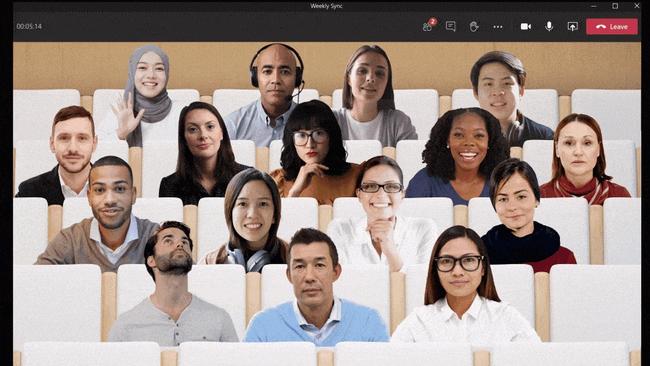Video conferencing has transformed the way we work and it’s only the start of the revolution
Zoom and Teams are among video conferencing services that are transforming the way we work, but it’s only the start of the video call revolution.

The tech giants, including Microsoft and Facebook, are working on technology that will allow you — or at least your avatar — to sit alongside your colleagues in a virtual meeting. It’s the latest development of video technology that has been embraced enthusiastically across the world as the pandemic forced employees out of the office and into remote working. The innovations may seem sudden but the technology for online video calls has been around for almost two decades.
A group of Estonians, a Swede and a Dane pumped out the first version of Skype from Estonia’s capital, Tallinn, in 2003. Skype was sold to eBay, then to a consortium involving a Canadian pension fund before ending up in Microsoft’s hands in 2011. That was when Skype became a verb as parents, children and friends “Skyped” online. Many other video-call services followed.
Videoconferencing in business goes back even further: it has been 25 years since the launch of Webex, which today is part of a suite of online meeting and sales tools owned by Cisco. In 2011, Eric Yuan, corporate vice-president of engineering at Cisco, left the firm with about 40 fellow engineers to form a company called Saasbee. A year later it was renamed Zoom.
Yuan’s is a remarkable story. He told Authority Magazine that his visa application to work in the US was rejected eight times. He got it on the ninth attempt and today he is a Californian billionaire. The idea for Zoom came to him when as a student he was studying in China and had to take an eight-hour train ride to see his girlfriend.
Zoom has been a useful tool for years but it took the pandemic to catapult it to a global phenomenon, proving the argument that technology can exist for a long time before it is adopted on a mass level. One example: the concept of combining TV and data services dates back to the early 1980s and by the 2000s the technology had developed into an early version of a smart TV in the shape of the Microsoft Media Centre. But it took many years for smart TVs to be a common household device.
Zoom and other videoconferencing services have been embraced widely thanks to COVID-19. Businesses wonder why they paid thousands of dollars for staff to attend international conferences they can now attend online; schools and universities have learnt to hold classes and meetings with dozens of attendees. Zoom and Skype, Google Duo, WhatsApp, Messenger and other services are now commonplace, but the pandemic has sparked a fresh battle between the tech heavyweights who are accelerating their release of new video tools and further stretching the concept of video communications.
Videoconferencing is now being integrated into standard business software solutions such as Office 365. Typical features include improved security and call encryption, more controls for the media host managing a video meeting, virtual rooms where you split a large video call into several smaller group discussions, fake backgrounds that can disguise your video setting, the ability of the software to automatically highlight the person talking, and automatic voice-to-text meeting transcription.
More is on the way. Microsoft has announced virtual reality conferences as part of Microsoft Teams. Here your avatar can sit alongside other people. Instead of appearing as a small tile in a big lattice of dozens of participants, you (or the virtual you) can sit with other people in a lecture theatre or at a coffee table.
Microsoft corporate vice-president Jared Spataro says the avatars can focus on other people’s faces and body language and can pick up the non-verbal cues important to human interaction as they would in physical meetings. This “together mode” is different from virtual reality (VR), where you wear a headset to visit another world and meet your colleagues there. In this latest innovation, you appear with others on the display screen. Mock-ups released by Microsoft show your avatar as the real you rather than a cartoon look-alike.
There are even more ambitious projects in train around “social VR”, which places you in an imaginary social setting where your avatar socialises and chats with others. You take part in joint activities such as games.
AltspaceVR — these days also owned by Microsoft — allows you to participate using a normal display, but you can become totally immersed in a make-believe environment if
you wear a VR headset. You don’t appear as the real you in the virtual environment, but you can pick a look-alike avatar to be you. AltspaceVR brings together people across the world, and hosts live shows, classes and meet-ups. The avatar sitting close to you may be of a person thousands of kilometres away. As well, AltspaceVR can generate personal conference rooms, auditoriums, cinemas and apartments where you can host your own events.
Facebook has invested in this area, too. Virtual environments and meet-ups have been among Mark Zuckerberg’s passions for years.
Facebook bought headset maker Oculus VR in 2014 to explore this area and created a virtual reality app called Facebook Spaces where you could interact with up to three Facebook friends in a virtual setting around a table. It eventually axed Spaces and replaced it with a more ambitious project, Facebook Horizon, and in March circulated various innovations for people to test. Facebook also has been buying up VR games developers to help build the platform. Like Altspace VR, Horizon represents participants as cartoon avatars in a virtual world.
It’s exciting but also unlikely these new-age ventures will be popular throughout the community in their present forms. VR headsets are large and uncomfortable, but when they become as unobtrusive and lightweight as sunglasses and when your avatar looks like you, the idea of meeting people across the world in VR may take off. Facebook’s vision is that, one day, you will select a group of Facebook friends and quickly get together in one virtual place. It’s where Second Life (the online virtual world with its own virtual currency launched in 2003) meets 2020s virtualised optics.
For now, we may need to be satisfied with Zoom and Teams.



To join the conversation, please log in. Don't have an account? Register
Join the conversation, you are commenting as Logout